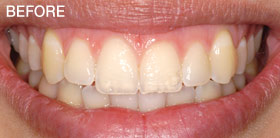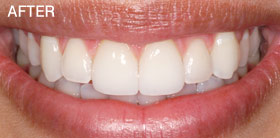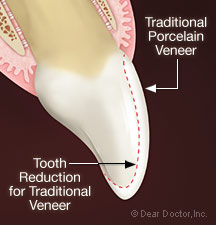Porcelain Veneers
A Cosmetic Enhancement for Teeth with Chips, Cracks, Stains
 |
|
 |
|
| Photos provided by Dr. Betsy Bakeman | |
A porcelain laminate veneer is a thin layer of dental ceramic material that is fixed to the outer surface of a tooth with a special resin adhesive. Veneers essentially replace tooth enamel. They enhance teeth cosmetically by masking a variety of minor to moderate dental imperfections. Working with dentists to pick an appropriate shade of porcelain, dental technicians can skillfully replicate natural enamel. Veneers do not stain the way teeth do, and can last seven to 20 years or even longer. That's because porcelain is hard, strong, durable, translucent in an attractive, glass-like way, and highly resistant to chemical attack.
What Can Veneers Do?
- Change the color of badly stained teeth
- Cover minor cracks in teeth
- Restore chipped teeth
- Close minor to moderate spaces
- Correct minor bite problems
- Build up teeth that have been worn down by grinding habits
- Compensate for excessive gum tissue
What Can't Veneers Do?
- Take the place of orthodontics when teeth are badly out of position
- Attach to insufficient tooth structure
- Compensate for asymmetrical gum tissue
What Is the Process of Restoring Teeth with Veneers?
If your dentist determines you are a good candidate for veneers, you can expect the process to take about two to three visits (including the initial consultation) over one to three weeks depending on whether the dental laboratory is in-house or not. The best way for your dentist to begin the process of designing your new smile is to create a model of your teeth, and then use it to make a provisional set of veneers out of plastic. You can actually wear these for up to two weeks to see if you like the effect. Once you and your dentist agree on the form and the shade of your veneers, specifications are sent to a dental laboratory. There, skilled technicians will mix porcelain powder with water, form it around a mold of your teeth, and bake it in an oven. Several layers are built up to mimic the translucency of real enamel.

Before the veneer is bonded to the tooth, a small amount of the tooth's surface — 1 mm or less — is usually removed in a process known as reduction. This often requires local anesthetic. There is, however, a relatively new procedure requiring no tooth reduction, referred to as the no-drill or prepless porcelain veneer. While veneers are most effective with minimal reduction (also called minimal prep), prepless veneers have the advantage of being reversible. But they are not appropriate in all situations.
There is no substitute for your dentist's talent and expertise in the various cosmetic techniques and materials. These skills — combined with a clear understanding of your goals and a diagnosis based on a thorough evaluation — are critical to assure the successful result of a beautiful smile.
How Do You Care for Porcelain Veneers?
Porcelain veneers are strong enough to withstand normal flossing and brushing with any non-abrasive fluoride toothpaste; they should be cared for in the same manner as completely natural teeth. However, porcelain is a glass and like all glass, veneers can shatter if bent. Within reason, you can eat almost anything with veneers, but you wouldn't want to crack nuts against them or chew on bones. And if you grind your teeth at night, you may need to wear a night guard to protect your veneers.
Find a Cosmetic Dentist today that offers porcelain veneers or learn more about Cosmetic Dentistry.



